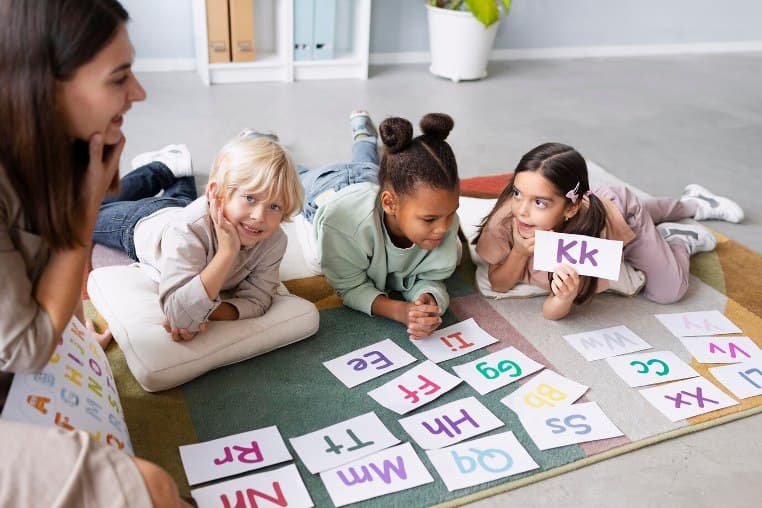With the goal of helping kids learn social and emotional skills, Conscious Discipline is a complete discipline curriculum for both parents and teachers. But first, you’ll have to know how to use conscious discipline in the classroom properly.
Conscious Discipline in the classroom entails creating a good, supportive, and safe environment for kids and teaching them how to regulate their behaviors and feelings. Teachers can employ a variety of methods and techniques to implement conscious discipline in the classroom. For example, the teachers may model the attitudes and behaviors they want their students to develop.

Image credit by freepik
There is no denying that application significantly impacts success rates, which is the most crucial aspect of any technique. Let’s learn some fundamental and effective methods for implementing conscious discipline in the classroom.
What is Conscious Discipline?
Before applying these methods in crucial places like classrooms, let’s get to know what conscious discipline is all about.
It is based on the belief that children are naturally capable of self-regulation and learn best when in a safe and supportive environment. It is founded on the principles of connection, cooperation, and choice and emphasizes the importance of creating a culture of empathy, resilience, and problem-solving in the classroom or at home.
The program includes a variety of strategies and techniques that adults can use to help children develop the skills they need to become responsible, respectful, and successful members of their communities. These strategies include using positive language and communication, setting clear limits and expectations, using positive reinforcement, and modeling appropriate behavior.
Conscious Discipline is used in a variety of settings, including schools, early childhood education centers, and home-based childcare programs. It has successfully upheld social and emotional learning and improved behavior and academic performance among kids and students.
How to Use Conscious Discipline in the Classroom
Teachers can assist their students in acquiring the skills they need to be responsible, respectful, and successful learners by utilizing the following strategies and techniques to establish a good, encouraging, and safe learning environment.

Image source: Freepik
Here are some ways you can use conscious discipline in the classroom:
- Establish a safe and supportive environment: Create a safe and encouraging environment. This entails establishing clear boundaries and expectations as well as fostering an atmosphere of cooperation, respect, and problem-solving.
- Use positive language and communication: The teachers should always use positive conversation and language. Avoid criticism or blame by using positive words and phrases.
- Use positive reinforcement: Use positive reinforcement to their advantage by praising, focusing on, or otherwise rewarding good conduct.
- Model appropriate behavior: Demonstrate the attitudes and behaviors you want your students to learn by acting in a way that is acceptable for the situation.
- Use problem-solving strategies: Help your students gain the skills they need to handle disagreements and solve problems on their own by teaching them problem-solving tactics.
- Teach social and emotional skills: Teach social and emotional skills by involving your pupils in activities and lessons that will teach them how to control their emotions and behavior and show kindness and empathy to others.
- Create a sense of belonging and connection: Create a sense of belongingness for your students by encouraging good relationships and a sense of community among them.
By implementing these tactics and approaches, you may create a positive, supportive, and secure learning environment for your kids and assist them in developing the skills they need to be responsible and successful learners.
Does Conscious Discipline Work?
Conscious Discipline is a widely used and well-respected discipline program that has been shown to promote social and emotional learning, improve behavior and academic performance, and significantly reduce stress in the classroom.
Studies have found that teachers who use conscious discipline report fewer behavior problems in their classrooms, and those students who participate in conscious discipline programs show improved social skills, emotional regulation, and academic performance.
However, it’s important to note that conscious discipline is just one of many different approaches to discipline and behavior management, and what works for one teacher or student may only work for some.
It’s important to find an approach that works for you and your students and to be willing to adapt and modify your approach as needed.
What is Conscious Discipline for Teachers?
Conscious Discipline is a complete discipline program for teachers that focuses on teaching children social and emotional skills. It is designed to help adults create a positive, supportive, and safe environment for children and teach them how to manage their own behavior and emotions.

Picture credit by freepik
The program includes a variety of strategies and techniques that teachers can use to help students in acquiring the knowledge and abilities necessary to succeed as accountable, respectful, and contributing members of their communities.
These strategies include using positive language and communication, setting clear limits and expectations, using positive reinforcement, and modeling appropriate behavior.
By using conscious discipline in the classroom, teachers can create a positive and supportive learning environment for their students and help them develop the skills they need to be successful learners.
How conscious discipline affects the students in the classroom?
Thorough research and books have been written about how mindful classroom discipline helps children develop more vibrancy in their personalities.
Dr. Becky A. Bailey, a well-known educator, and author, wrote in her book “BUILDING RESILIENT CLASSROOMS“ You might observe the following significant changes in your student:
- Improved emotional intelligence: Conscious Discipline teaches students to understand and control their emotions and reactions, leading to better self-confidence and self-awareness.
- Increased focus: It helps students to stay on task and develop better concentration skills, resulting in improved academic performance.
- Improved cooperation: Conscious Discipline teaches students to work together cooperatively and be more respectful of each other, leading to more harmonious relationships.
- Enhanced communication skills: It teaches students to successfully listen and communicate with one another and their professors, resulting in more meaningful conversations and healthier relationships.
- Greater respect for authority: Influence students to respect authority figures positively, leading to an atmosphere of trust and cooperation.
- Improved problem-solving skills: Conscious Discipline helps students to think through problems and develop creative solutions, leading to more successful problem-solving outcomes.
- Enhanced self-esteem: Makes students recognize their own strengths and weaknesses, leading to increased self-esteem and improved self-image.
- Improved behavior: Conscious Discipline teaches students to take responsibility for their actions and make better choices, leading to improved classroom behavior.
Conclusion
Conscious Discipline provides students with a framework to help them become successful, confident individuals. Through positive discipline strategies and proper knowledge about how to use conscious discipline in the classroom, students can learn how to manage their emotions, make good decisions, and solve conflicts respectfully.


